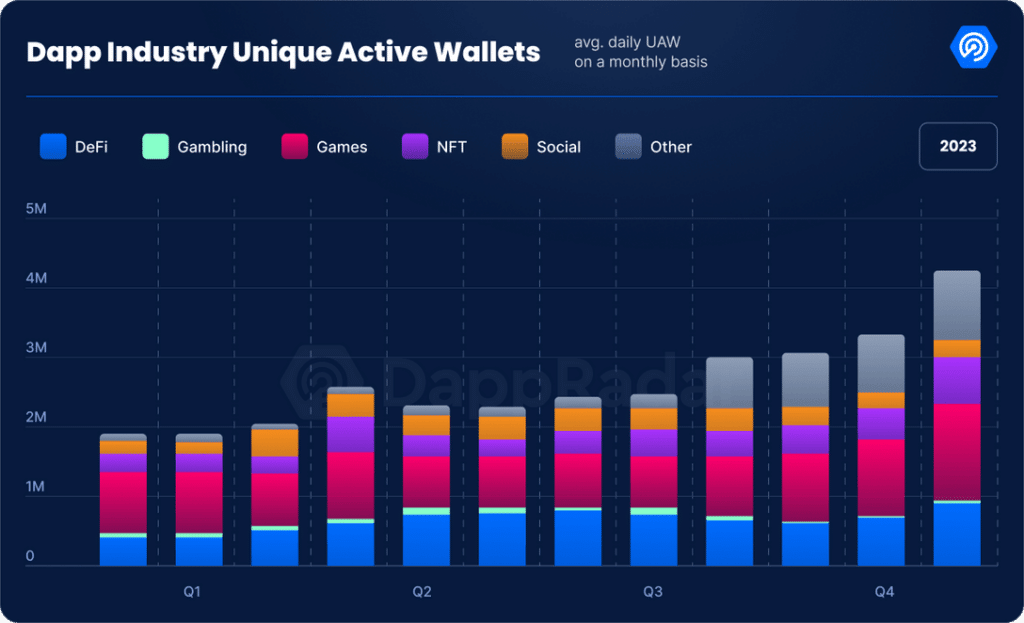Competition in the dapp arena is heating up as developers weigh Binance Smart Chain against Ethereum. How do factors like scalability and transaction costs influence their decisions?
The blockchain space is fiercely competitive, especially when it comes to decentralized applications (dapps).
According to data from DappRadar, a prominent analytics platform, as of February 2, Binance Chain (BNB) leads the way with 5,215 dapps and a user base of over 5.3 million unique active wallets (UAW) in the past 30 days.
Ethereum (ETH), on the other hand, holds the second position with 4,497 dApps, although its user base of approximately 1.36 million UAWs pales in comparison to Binance Chain.

Leading blockchain platforms for dapp development | Source: Dapp Radar
However, Ethereum’s dapps volume stands at an impressive $115 billion, more than six times Binance Chain’s $17.5 billion, underscoring the substantial developer involvement in Ethereum.
Amid this, Xin Jiang, former vice president at Binance, suggested that the market may not need further infrastructure improvements as dapps could emerge as the next catalyst for the crypto space.
What is happening? Let’s take a deeper look at how the dapp market is performing, which chains are leading the development and which sectors are driving the dapp market to new heights.
The current state of the dapp market
According to a report by DappRadar, the dapp industry witnessed an impressive 124% year-over-year increase in UAW, culminating in a daily count of 4.2 million UAW by the end of 2023.
Fast forward to early 2024, and the momentum shows no signs of slowing. As of February 1, the dapp industry has reached a new milestone with 5.3 million daily UAW. This represents an increase of 18% from the previous month and the highest since 2022.
Breaking down the figures by industry segment provides insight into the diversification of dapp use.

Source: Dapp Industry Report 2023
Blockchain gaming continues to lead the pack with a stable 1.5 million dUAW, maintaining its dominance from the previous month. This translates into a 28% dominance over the entire dapp ecosystem,
Likewise, the decentralized finance (defi) sector remains strong and remains stable at 1 million dUAW.
However, it’s not just gaming and finance that are driving growth. The non-fungible token (NFT) space has seen remarkable expansion, up 4% this month, reaching 697,959 dUAW.
Amid this, the social dapp sector has made headlines, with an impressive 868,091 dUAW. This increase, a 262% increase from the previous month, is largely attributed to platforms like CARV and Dmail Network, indicating a surge in interest in social networking on decentralized platforms.
Rise of social dapps
The growing popularity of social dapps comes in response to rising concerns about data privacy breaches and online scams on traditional platforms.
Technology mogul Elon Musk’s acquisition of Twitter in 2022 caused a wave of discontent among its user base. Subsequent changes, such as consideration of a paywall, led to a decline in monthly active users, which is expected to continue into 2024.
Amid this, social dapps like Friend.tech gained popularity. Friend.tech launched in August 2023 and quickly became a major player in the social crypto scene, with over 100,000 users and $25 million in revenue.
But the shift to decentralized apps isn’t just about dissatisfaction with centralized platforms. Analysts emphasize that regulatory scrutiny and privacy concerns, especially in the EU, are also driving this trend.
Dapps differ from traditional platforms in that they avoid centralized data collection for advertising, with some being nonprofits and prioritizing user privacy.
While decentralized platforms offer greater freedom and anonymity, they also attract communities with extreme views, raising concerns about the spread of extremist content.
Based on data from DappRadar, CARV, Galxe and Dmail Network have emerged as the top social dapps as of February 26, when measured by total UAWs in the past 30 days.
CARV and Dmail Network have seen significant growth, with volumes increasing by 330% and 120% respectively. However, Galxe has experienced a significant drop to 100%.
Why is Binance Chain leading the dapp race?
When we compare Binance Smart Chain (BSC) and Ethereum in terms of dApps performance, scalability, transaction fees, and consensus mechanisms, we gain insight into their strengths and weaknesses.
BSC stands out for its low transaction fees and high scalability, allowing fast transaction processing at a fraction of the cost compared to Ethereum.
As of February 26, BSC can process up to 45.3 transactions per second (TPS), a significant improvement over Ethereum’s current throughput, which remains below 15 TPS but is aiming for a substantial increase with Ethereum 2.0.
Transaction fees on Ethereum are an ongoing problem, averaging $0.89 as of February 25. During periods of network congestion, these costs can skyrocket even further, creating challenges for users and developers.
In contrast, BSC offers significantly lower transaction fees, averaging $0.15 at the time of writing, offering a compelling advantage for those seeking more cost-effective blockchain interactions.
The choice between BSC and Ethereum depends on the specific needs and priorities of dapp developers and users. Each platform has its tradeoffs in terms of decentralization, security, transaction speed, and costs.
BSC excels in providing an efficient and economical solution for high-frequency trading and applications that require fast transaction speeds and low fees.
On the other hand, Ethereum’s strength lies in its robust decentralization and security measures, along with a diverse range of dapps and a vast ecosystem.
The road ahead
The success of decentralized applications depends on improving the user experience to make blockchain-based solutions more accessible. Simplifying interactions, refining interfaces, and integrating familiar features are crucial to attracting a broader audience.
In today’s security-conscious digital world, dapps must also prioritize robust privacy and security measures. Innovations in cryptographic techniques such as zero-knowledge proofs and secure multi-party computation will be essential for improving security.
While finance and gaming have dominated the dapp scene, there is opportunity for expansion into new areas such as social media, education and healthcare.
Ultimately, the goal of dapps is mainstream adoption. To achieve this, not only technological developments are needed, but also educational initiatives to highlight the practical benefits of dapps in everyday life.

